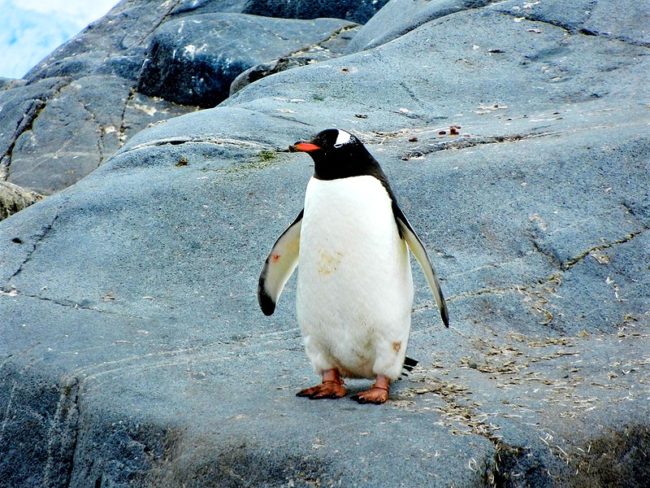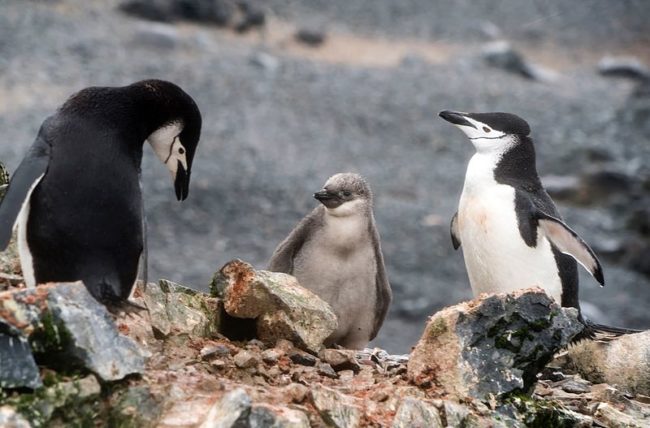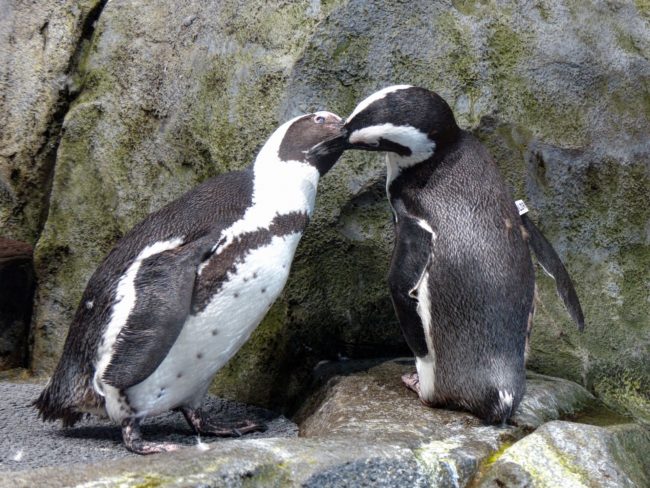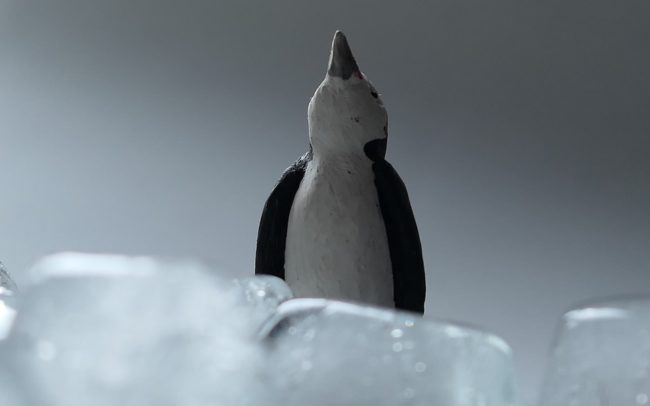Chinstrap Penguin – The Complete Guide
The species’ name – chinstrap penguin, comes from the abundance of black feathers, which give the penguins their nickname “chinstrap.” It also has a narrow black band beneath its head, making it look like it’s wearing a black helmet.
Chinstrap Penguin
Various islands and beaches on the Antarctic and Southern Pacific Oceans are home to chinstrap penguins. Other words refer to the chinstrap penguin: ringed penguins, stone crackers, and bearded penguins.
Today, we bring you a detailed analysis of these cute birds, the chinstrap penguins. Are you ready to dive? Let’s go!

How Do Chinstrap Penguins Appear And Behave?
We can quickly identify chinstrap penguins by noting the white face and black under the beaks.
Male and female chinstrap penguins have similar colors and patterns, making it nearly impossible to distinguish the genders visually.
Children have spots around the face until their first flake, which occurs once a year.
Chinstrap Penguins, like other penguins, utilize their flippers to ‘fly’ up to 25 miles per hour. Chinstraps frequently ‘toboggan’ on land on their bellies, propelled by their feet and flippers.
Chinstrap Penguins use all four limbs to climb out of the sea and up steep hills, and they can jump long distances to seek footholds.
What Are Chinstrap Penguin Habitat?
Chinstrap Penguins’ habitats include coasts and oceans. They often reside on islands and distant continental regions with few predators, where their inability to fly allows them to survive using their flippers. They’ve evolved to live in the water.
What Are The Reproduction Cycle And Life Span Of Chinstrap Penguins? How Many Babies Do They Have?
Chinstrap penguins use stones and pebbles to build a circular nest. Nests of chinstrap penguins are about 40-45 centimeters in diameter and 15-20 centimeters tall.
The female penguin lays two eggs in November or December, kept warm by male and female penguins. The eggs hatch after 15 to 33 days. The parent penguins then take turns feeding them for 6 to 10 days while the other partner is hunting for food.
The chicks, also known as nestlings, remain in the nest until they are between 20 and 30 days old. They have feathers at this stage to keep them warm in the winter weather.

After 20 or 30 days, they join the crèches, small groups of baby penguins who huddle together for warmth and safety. Chinstrap Penguins have a lifespan of 15 to 20 years.
What Are The Significant Predators And Threats Of Chinstrap Penguins?
Orcas and leopard seals threaten chinstrap penguins. At the same time, chicks and eggs in the nest are vulnerable to birds such as giant petrels and skuas.
The leopard seal eats almost anything but mainly feeds on penguins, fish, squid, and crustaceans. Leopard seals are penguins’ significant predators in the water.
On land, chinstrap penguins face threats from giant petrels, skuas, and other birds that steal their chicks and attack their eggs, as well as a unique threat: Antarctic volcanic activity.
As the penguins go through their yearly flake, Zavodovski Island has many penguin feathers. They become landlocked when their waterproof feathers are lost during molt and cannot return to the sea until they recover.
What Is A Chinstrap Penguins Diet?
The food diet of the Chinstrap Penguin consists of small shoaling and schooling animals: squad, krill, small fish, and other roaming marine crustaceans.
Chinstrap penguins feed by pursuit-diving for prey or small fish close to their breeding colonies. Antarctica’s vast seas are where their prey is found and reside.
Chinstrap Penguins are classified as near-shore feeders as they dine amid the mount of icebergs.
What Are Chinstrap Penguin Fun Facts?
Most of us know them as a part of the penguin species, but they hold some unique distinctions too from other penguins
- Chinstrap penguins are the most numerous penguins, with an estimated population of eight million breeding pairs
- Chinstrap penguins can dive to depths of 230 ft (70 m)
- Most dives are shorter than 45 m (148 ft) and last 20 to 30 seconds
- A chinstrap penguin chick has grey feathers and a black beak till the age of 14 months, and these newborn penguins are lovely!
- Chinstrap penguins may grow 28 to 30 inches tall and weigh 6.5 to 10 pounds. Males stand taller and weigh more than females
- Chinstrap penguins have tough, waterproof feathers
- The Chinstrap penguin is also known as the “stone cracker penguin” because of its piercing sounds
- The Chinstrap penguin has red eyes, a small, black beak, powerful legs, and pink webbed feet
- Chinstrap penguins are frequently said to as the most aggressive species of penguin
- Many chinstrap penguins mate for life and get together 82% of the time

How Do Chinstrap Penguin Adapt?
Every day, Chinstrap Penguins swim 50 miles or 80 kilometers offshore.
They have tight-packed feathers, like other penguins, to keep them waterproof, as well as a thick layer of fat with blood vessels in their extremities that transmit heat to essential organs.
They can withstand extreme cold because of the insulation provided by their tightly packed feathers. A thick layer of blubber or fat also stores energy.
What Is The Height Of Chinstrap Penguins?
Adult Chinstrap Penguins’ average height is 71–76 cm (about 28–30 inches) in length, and typically weight is around 3–6 kg (about 7–13 pounds).
Medium-sized chinstrap penguins can stand about 2 feet high. Their weight or height fluctuates throughout the year, coinciding with the flow of food.
At their heaviest, adults weigh up to 12 pounds. Their body shape may reduce water resistance and allow chinstrap penguins to cut through the water quickly, which helps the chinstrap penguins to swim fast to capture their prey and evade predators.
Unlike many other penguin species, female and male chinstrap penguins are roughly the same size and closely resemble each other.
Black feather patches around their eyes may identify chinstrap Penguins. In terms of size and appearance, children are comparable to adult penguins.
What Is The Scientific Name Of Chinstrap Penguins?
Chinstrap penguin (Pygoscelis antarcticus) is also called bearded or ringed penguin. Pygoscelis antarcticus or the Chinstrap penguin is the smallest of the three species of Pygoscelis penguins.
The Chinstrap Penguin derives its name from a strip of dark or black feathers behind the chin, mimicking a strap that keeps the penguin’s head in place.
Chinstrap Penguin Nest
Chinstrap penguins spend much time in the winter on land, north of their breeding colonies and icebergs in warmer waters.
They even nest on rocky slopes, steep with the male penguin often constructing circular enclosures.
Breeding females produce two eggs between late November and early December. Both parent penguins look after the eggs, incubating them in shifts of 5–10 days over the next 20–30 days. After hatching the eggs, the parent’s shift length falls to 35 hours.
Chicks, which emerge from their eggs in January, remain in the nest until early February before joining “creches” or groups with other members of their group for protection and warmth while their parents forage for food. Throughout March, The young are ready for adulthood when they have matured.
Some 50 to 60 days after they hatch, the young chinstrap penguins feed in the sea for the first time. They become sexually mature between ages three and seven, and they may live as long as 15–20 years.
Some penguins are prone to producing occasional very pale individuals, sometimes as “blonde” penguins, known scientifically as ” leucistic” forms.
Are Chinstrap Penguins Social?
Chinstrap penguins are very social. They gather together in enormous colonies onshore during the breeding season and are more vocal.
They communicate with ceremonial behaviors such as the flipper and head waving, calling, bowing, pointing, and preening their coats.

Chinstrap Penguins Are Very Social
Chinstrap Penguins make sounds like “Kauk, Kauk, Kauk” while raising their flippers and moving their head from side to side. There may be stares, meaning, and charging when territorial issues occur.
How Do Chinstrap Penguins Feed?
Chinstrap penguins or nestlings get feed about once a day on average, with the returning parent penguin bringing back about 300g of krill or fish.
Statistics prove that adults travel roughly 20-30 kilometers from their colony to locate prey or fish for about 200 kilometers.
Newborn penguins, called nestlings, entirely depend on their mother penguins for a few months. After some days, they swallow prey and pebbles; until then, a mother feeds her nestlings.
The mother penguin feeds her nestlings by vomiting up the meal she consumes into the beaks and down the throats of her fluffy nestlings or newborn penguins.
Some mother penguin species may consume fish or prey and keep it in their stomach for up to a day before fully digesting it. Then, they can vomit food to feed their young penguins.
Although it seems like kind of a disgusting process to humans, it’s the perfect way for a penguin to take care of nestling in the type of nourishment it can digest.
The female penguins remain in the nest, looking after the chicks until the parent penguins turn. They are large enough to maintain their body temperature and wander around freely in the colony.
As they age, chinstrap penguin chicks huddle together for protection from predators as well as the worst of the weather or temperature. It also frees up both of the parents’ penguins to go fishing. As a result, it would enhance the food supply for quickly growing chicks.
How Deep Can Chinstrap Penguins Dive?
Chinstraps can dive as deep as 230 feet or 70 meters, but usually, chinstrap penguins attack reasonably shallow in the sea compared to some other penguin species. They typically dive in less than a minute.
How Fast Do Chinstrap Penguins Swim?
Chinstrap Penguins can swim around 18mph or 30kph in the sea. They ‘toboggan’ on land by lying on their bellies and pushing themselves along the iceberg.
What Is The Global Population Assessment Of The Chinstrap Penguin?
The chinstrap penguin colony on Zavodovski Island in the South Atlantic Ocean is estimated to have a population of 1.2 million breeding pairs, which was why it’d named the world’s “Largest penguin colony!” by the Guinness Book of World Records. In comparison, the island has more penguins than inhabitants in San Francisco!
By 2021, the global adult chinstrap penguin population will reach at least 8 million. But several studies have highlighted significant declines at monitored sites.
There is no perfect data on how much they decrease as chinstrap penguins nest in remote and rugged areas; on-the-ground census work is difficult, expensive, and sporadic.
As a result, documentation of global Chinstrap penguin abundance and distribution has, to date, been unavoidably incomplete, and many regions where Chinstrap penguins breed have not been visited or surveyed since the early 1980s.
Without an accurate count, it is impossible to form a complete picture of the species’ distribution and assess its population dynamics over time.
However, statistics show that the global population is dropping due to climate change.
What Is The Current Population Of Chinstrap Penguins?
Even though their population is generally declining, their numbers remain steady thanks to breeding couples. Thus, on 05-Aug-2021, Pygoscelis Antarctica, also known as the chinstrap penguin, is rated as Least Concern on the IUCN Red List.
How Long Do Chinstrap Penguins Live?
Antarctica and the sub-Antarctic Islands are home to the Chinstrap penguin. Chinstrap penguins can live in the wild for up to twenty years.
What Is The Conservation Status Of Chinstrap Penguin?
They estimate ecologists that the worldwide chinstrap penguin population exceeds 15 million birds. The largest population, estimated at eight million breeding pairs, occurs in the South Sandwich Islands.
From 1988 to 2021, the chinstrap penguins were listed as the species with little risk of extinction, agreeing to the International Union for Conservation of Nature (IUCN), which gives them a rating of Least Concern due to their high population and wide geographic spread.
Conclusion
The chinstrap penguin is recognizable: a black crown on top of its head, a white face, and a collar with a continuous band of black feathers spanning from one side of the head to each cheek and under the chin.
A thin ring of black skin around each eye and a black bill are other distinctive traits due to its loud, harsh cry and all these features.
The facts to get cleared with answers are indeed interesting. I hope you got the response to the factual discussion that happened one day with your friends or family where you left the space filled with sheepish smiles.
Image Source
- Penguin standing on rock by Jay Ruzesky wolsenburg / CC BY
- Chinstrap Penguin Chicks With Its Parents by Christopher Michel / CC BY
- Chinstrap Penguins Mating by Linnaea Mallette / CC BY
- Penguin Ice South Pole Animal Cold Water / CC BY
Reference
https://www.pewtrusts.org/-/media/assets/2014/10/ccamlr/protecting_chinstrap_penguins_fact_sheet.pdf
https://www.nationalgeographic.com/animals/birds/facts/chinstrap-penguin
https://seaworld.org/animals/facts/birds/chinstrap-penguin/
https://www.coolantarctica.com/Antarctica%20fact%20file/wildlife/chinstrap-penguins.php
https://www.bas.ac.uk/about/antarctica/wildlife/penguins/chinstrap-penguin/
https://www.britannica.com/animal/chinstrap-penguin
https://animals.mom.com/physical-characteristics-chinstrap-penguin-9512.html
https://oceanwide-expeditions.com/to-do/wildlife/chinstrap-penguin
https://www.pbs.org/wnet/nature/blog/penguin-fact-sheet/
https://www.nature.com/articles/s41598-020-76479-3
